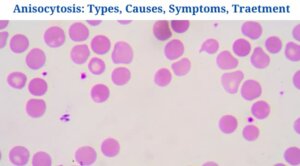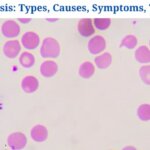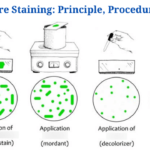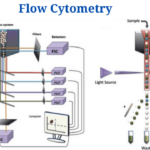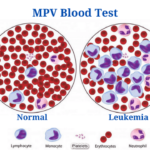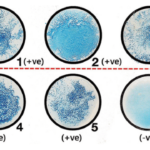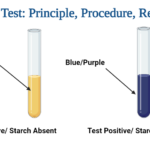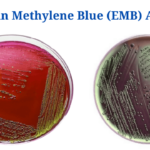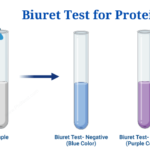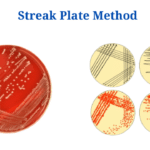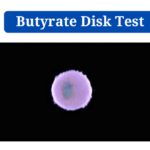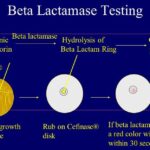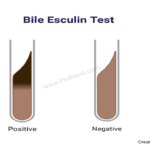Definition of Anisocytosis
Anisocytosis is a condition in which the diameters of erythrocytes (red blood cells) are uneven.
- The term “aniso” means unequal, while “cytosis” means cell movement or quantity.
- Excessive red blood cell size variation, known as anisocytosis, can be quantified by peripheral blood film analysis as well as automated red blood cell size distribution analysis.
- A quantitative metric of anisocytosis is the red cell distribution width (RDW).
- RDW is a measure of erythrocyte volume variability which is commonly conducted as part of the red blood cell count by automated cell counts.
- It’s computed by dividing the mean corpuscular volume by the coefficient of variation of the RBC volume distribution (MCV).
- Anisocytosis is not a disease in as well as of itself; it is linked to other diseases such as iron deficiency anaemia as well as/or other blood disorders.
Figure: Human red blood cells from the case of anisocytosis
Types of Anisocytosis
Three forms of anisocytosis can be identified based on the size of the erythrocytes as well as the reason of anisocytosis:
A. Anisocytosis with Macrocytosis
- Anisocytosis with macrocytosis is a condition in which the size of the erythrocytes is bigger than normal.
- Megaloblastic anaemia (Vitamin B12/Folate deficiency), myelodysplasia, as well as liver disease all cause anisocytosis with macrocytosis.
- It is also linked to the use of antimetabolite or as well as rogen drug therapy, as well as a milder form of macrocytosis is seen frequently in alcoholics.
B. Anisocytosis with Microcytosis
- Anisocytosis with microcytosis is a condition in which erythrocytes are smaller than normal.
- Iron deficiency anaemia, sideroblastic anaemia, some thalassemias, lead poisoning, and certain hemoglobinopathies are all known to cause anisocytosis with microcytosis.
C. Anisocytosis with Normocytosis
- Anisocytosis with normocytosis occurs when the size of the erythrocytes is normal but the number of RBCs is low.
- This is frequently linked to normocytic anaemia.
Causes of Anisocytosis
Anisocytosis can be caused by a variety of factors
- Because anisocytosis is not a disease in as well as of itself, it is frequently associated with other types of blood disorders.
- The most common cause of anisocytosis is anaemia. Anemia can result in anisocytosis in a variety of ways.
- The following are some of the most frequent anemias as well as other medical problems linked to anisocytosis:
A. Iron deficiency anemia
- The most frequent type of anaemia is iron deficiency anaemia.
- It is caused by a shortage of iodine in the body, which is usually caused by excessive blood loss or a dietary deficiency.
- Iodine is stored in RBCs, which aids in the transport as well as storage of oxygen in the blood. The size of RBCs changes as the iodine content is reduced.
- Anisocytosis with microcytosis is the most common symptom of this anaemia.
- Because they require more iron to create RBCs for the infant, anisocytosis owing to iron deficiency anaemia is frequent during pregnancy.
B. Sickle-cell anaemia
- Sickle-cell anaemia is a hereditary disorder which causes sickle-shaped or crescent-shaped red blood cells to develop.
- Because it is a hereditary disorder, it can be passed on from generation to generation.
C. Thalassemia
- Thalassemia is a genetic condition in which the body produces abnormally large or different types of haemoglobin.
- Thalassemia, like sickle-cell anaemia, can be inherited.
- Anisocytosis with microcytosis is also a symptom of thalassemia.
D. Hemolytic anaemia
- Hemolytic anaemia is a collection of illnesses which occur when the body recognises RBCs as a foreign body as well as begins to kill them.
- This results from autoimmune disorders, infections, or a hereditary issue, as well as causes a decrease in the quantity of red blood cells in the blood.
E. Megaloblastic anaemia (megaloblastic anaemia)
- When the quantity of RBCs is reduced as well as the size of the surviving RBCs exceeds which of a typical red blood cell, megaloblastic anaemia develops.
- This kind of anaemia is caused by a shortage of Vitamin B-12 or a deficiency in Folate.
- Megaloblastic anaemia is characterised by anisocytosis as well as macrocytosis.
F. Aplastic anaemia
- Aplastic anaemia is a bone marrow condition in which the body produces insufficient blood cells.
- Viral infections, the use of aplastic anemia-related medicines, or exposure to harmful substances could all contribute to this illness.
G. Pernicious anaemia
- Pernicious anaemia is an autoimmune disease which arises when the body’s ability to absorb vitamin B-12 is impaired.
H. Other illnesses
- Anisocytosis can be caused by a variety of medical diseases, including blood abnormalities. Here are a few examples:
- Chronic liver disease
- Myelodysplastic syndrome (MDS)
- Disorders of the thyroid glands
- Haemoglobin H deficiency
- Deficiency in protein
- Diseases of the cardiovascular system
- Chemotherapy medications which are cytotoxic, or drugs which are used to treat cancer.
Anisocytosis Symptoms
Because the problem is linked to the size as well as number of RBCs, it causes symptoms which are linked to a lack of oxygen flow to various organs in the body. Anemias as well as other blood-related illnesses have symptoms which are similar. Here are a few examples:
- Weakness as well as exhaustion
- Even with moderate exercise, you may have shortness of breath.
- Pain in the chest
- Dizziness as well as headache
- Skin which is pale
- Hands as well as feet are freezing.
If anisocytosis is not treated, it can lead to a variety of problems, including:
- White blood cell as well as platelet counts are dropping.
- Nervous system dysfunction
- Increased heart rate in a short period of time
- Major pregnancy difficulties, such as serious congenital diseases of the developing fetus’s spinal cord as well as brain (neural tube defects)
Anisocytosis Diagnosis
An anisocytosis diagnosis can be achieved in a variety of ways, the most frequent of which is a blood smear.
Blood Smear
- A blood sample is taken, as well as a tiny coating of it is smeared on a sterile glass slide.
- After that, the slide is dyed, dried, as well as examined under a microscope at the proper magnification.
- The staining aids in the differentiation of cell types as well as cell size.
- The amount of haemoglobin in each red blood cell, cell volume, as well as haemoglobin concentration in each red blood cell are measured as well as recorded using the smear, size, as well as shape, as well as the number of red blood cells.
An additional method which can be performed to diagnose anisocytosis is:
- Complete blood count
- Folate Test
- Vitamin B-12 Test
- Ferritin Test
- Serum iron level
Treatment
- The aetiology of anisocytosis determines the treatment.
- Anemia-related anisocytosis, such as vitamin B-12 deficiency as well as iron deficiency, can be easily managed with supplements as well as a healthy diet.
- More severe anemias, such as sickle cell anaemia as well as thalassemia, require blood transfusions or, in some cases, a lifetime of transfusions.
- A marrow transplant may be necessary in the event of megaloblastic anaemia.
Prevention
- An antidote to anisocytosis could be a balanced diet rich in essential nutrients as well as vitamins.
- In addition, various lifestyle adjustments, such as adequate food, supplementation, as well as exercise, may be beneficial.
Anisocytosis Citations
- Simel DL, DeLong ER, Feussner JR, Weinberg JB, Crawford J. (1988). Erythrocyte Anisocytosis: Visual Inspection of Blood Films vs Automated Analysis of Red Blood Cell Distribution Width. Arch Intern Med.1988;148(4):822–824. DOI:10.1001/archinte.1988.00380040062012
- ENGLAND, J.M., WARD, S.M. and DOWN, M.C. (1976), Microcytosis, Anisocytosis and the Red Cell Indices in Iron Deficiency. British Journal of Haematology, 34: 589-597. DOI:1111/j.1365-2141.1976.tb03605.x
- Davor Kust, Marko Lucijanic, Kristina Urch, Ivan Samija, Ivana Celap, Ivan Kruljac, Marin Prpic, Ivica Lucijanic, Neven Matesa, Ante Bolanca (2017). Clinical and prognostic significance of anisocytosis measured as a red cell distribution width in patients with colorectal cancer, QJM: An International Journal of Medicine, Volume 110, Issue 6, June 2017, Pages 361–367, https://doi.org/10.1093/qjmed/hcw223
- Seno S (1964). Mechanisms of Induction of Anisocytosis. Acta Haemet. 31. 129-136.
- https://www.ncbi.nlm.nih.gov/books/NBK263/
- https://www.medicalnewstoday.com/articles/319852
- https://www.sciencedirect.com/science/article/pii/S2468653017302671
- https://www.ncbi.nlm.nih.gov/pmc/articles/PMC4261384/
- https://www.ncbi.nlm.nih.gov/medgen/66371
- https://www.merckmanuals.com/home/blood-disorders/anemia/autoimmune-hemolytic-anemia
- https://www.ibuzzle.com/articles/iodine-deficiency-disorders.html
- https://rarediseases.info.nih.gov/diseases/8614/index
- https://www.medicalnewstoday.com/articles/326451
Related Posts
- Anisocytosis: Definition, Types, Causes, Symptoms, Treatment
- Endospore Staining: Principle, Procedure, Reagents, Results
- Flow Cytometry: Overview, Principle, Steps, Types, Uses
- Northern Blot: Overview, Principle, Procedure and Results
- MPV Blood Test: Calculation, High and Low MPV Value, Results
- Latex Agglutination Test: Objectives, Principle, Procedure, Results
- Iodine Test: Definition, Objective, Principle, Procedure, Results
- Eosin Methylene Blue (EMB) Agar
- Biuret Test for Protein: Purpose, Objectives, Principle, Procedure, Reagents
- Streak Plate Method: Meaning, Principle, Methods, Importance, Limitations
- Bile Solubility Test: Objective, Principle, Procedure, Results, Uses
- Butyrate Disk Test: Objective, Principle, Procedure, Results, Uses, Limitations
- Beta Lactamase Test: Objective, Principle, Procedure, Results, Limitations
- Bacitracin Susceptibility Test: Objective, Principle, Procedure, Results, Uses, Limitations
- Bile Esculin Test: Objective, Principle, Procedure, Result, Uses, Limitations

